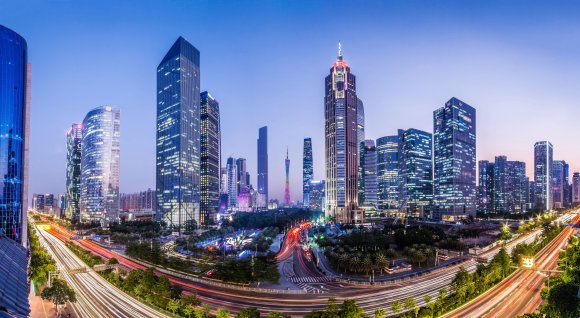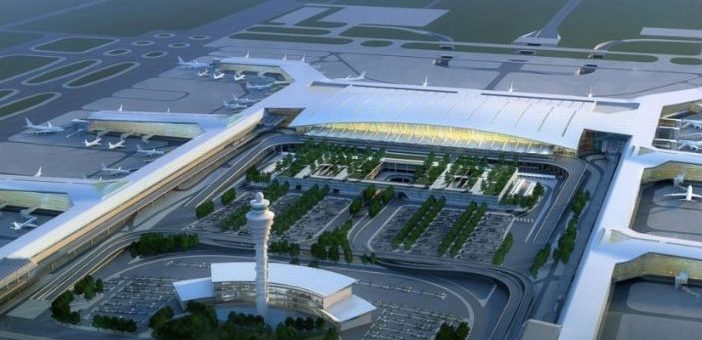After the opening of Guangzhou Line 14 (first phase), the first Metro running in Conghua District, Guangzhou has begun a new chapter of “metro access to all districts.” Guangzhou Metro services account for over half of the public transport journeys taken in the city. It is no doubt the fastest and most convenient way to get around.
Whether you are new to the city or a born and bred Guangzhouer, the following tips will help you have a nicer trip on the metro.
1. Finding a metro station
You can easily find the nearest metro station in Guangzhou, because the street level signs are a conspicuous and eye-catching bright red.
2. Security check
According to security check measures, passengers are required to go through a body scanner and have their bags passed through an X-ray machine. A priority lane is in operation for pregnant women, children under 1.2m and the disabled who needn’t go through the body scanner. Liquids must be taken out of your bag in advance and checked by an inspector. You are advised to arrive at the metro station earlier than usual as the security check lengthens travel time.
3. Buying a metro ticket
Cash: You can buy single journey ticket at the automatic ticket vendor machine which only accepts coins and 5 yuan and 10 yuan paper notes. If you don’t have small change, you can obtain change at the Metro Customer Service Center.
Alipay/Wechat: Automatic ticket vending machines now all accept mobile payment, simply select your payment option and scan the barcode.
Yang Cheng Tong: With this travel card, you don’t have to buy a ticket for each journey, but just tap it on the gate enter and exit. You can buy a Yang Cheng Tong Card at the Metro Customer Service Center or convenience stores like 7-11, Family-Mart, OK, C-Store and Meiyijia. You can top up the card via the self-help top-up machine at the metro station or at the above-mentioned convenience stores.
Within a calendar month, any holder of Yang Cheng Tong card enjoys a 5% discount on Metro rides only for the first 15 metro or bus trips. From the 16th time onward, the same card shall enjoy a 40% discount on bus or metro ride (the ride count is reset at the beginning of each calendar month).
Guangzhou Metro APP: Download Guangzhou Metro APP “广州地铁” (type: guang zhou di tie), register and log on with your phone number, click “乘车码” the QR code icon in the middle of the bottom row on the interface of the APP, click "立即开通" to activate the QR code function, grant the APP password-free payment via Alipay or WeChat Pay;
Click “扫码进/出站” to get the QR code, then scan it at a ticket gate at the entrance of each station, and scan again to exit at your destination station. Travel fare will be charged later after your journey is completed. The APP also provides useful functions such as viewing your journey history and issuing Fapiao (an official tax receipt).
WeChat mini program: Search for mini program “广州地铁乘车码” (type: guang zhou di tie cheng che ma) on WeChat, click “同意协议并开通” to activate the function, authorize password-free payment, then you will get the QR code to enter and exit the station.
These ticket gates also enable passengers to pass through using Union Pay cards with QP (quick pass) or smartphones with NFC.
Latest word: QR code payment has been applied to all the ticket gates in Guangzhou Metro since January 18th, 2019. Guangzhou Metro has reconfigured all the old ticket gates and ,now you can scan QR code at any ticket gate in the metro, according to officials. Remember to update your GZ Metro APP to the latest version, then you can scan QR code at all ticket gates.
4. Going through a ticket gate
When taking large luggage or baby carriages onto the metro, you can ask a metro attendant to help you take them through the barrier before you enter.
5. Free WiFi service
Guangzhou Metro offers free WiFi service on all trains and at all metro stations. Download APP “花生地铁” (type: hua sheng di tie), register with your phone number, then log in and search for “花生地铁WIFI” in your list of WiFi connections.
6. Identifying numbers
Guangzhou Metro has added numbers to all signs, platforms and platform screen doors throughout the network to help the elderly, children, and non-native speakers more easily recognize and identify various metro stations and lines.
7. Rent-free umbrella-sharing service
Guangzhou Metro offers a rent-free umbrella-sharing service. Passenger can rent an umbrella for 15 days with a deposit of just 20 RMB. If passengers can’t return the umbrella within 15 days, they are allowed to renew it free for another three days. But if passengers keep the umbrella beyond 18 days, they will be charged 0.5 RMB for each day it’s overdue. The late fee will be deducted from the deposit.
8. Night train
As to facilitate metro-transportation for late-arriving passengers at Baiyun Airport, Guangzhou Metro Line 2 has been operating a special night train from Jiahewangang (嘉禾望岗)since September 2016. The night train runs at 23:30 from Jiahewangang (嘉禾望岗)and stops only at the following stations: Guangzhou Railway Station (广州火车站), Gongyuanqian (公园前), Changgang (昌岗), Luoxi (洛溪) and Guangzhou South Railway Station (广州南站).
When the night train is running, there will be no transfer service as other metro lines are out of service during these hours. Therefore, passengers can only get off at the above stations and leave the metro to take other transportation.
9. Lost and Found
You can report things you have either lost or found in the metro via Guangzhou Metro’s official WeChat account “广州地铁” (type: guang zhou di tie). Follow the account on WeChat, click “96891微客服” in the middle of the bottom row, click “失物招领” (shi wu zhao ling) to enter the information of the things you lost or found. The webpage is in Chinese. Alternatively you can call 96891 to make the report.
10. Nurseries
Traveling with a baby can be a little challenging, especially when you need to breastfeed him/her or change a diaper and you can’t find a quiet place. If you need to do that when taking the metro please note the following metro stations that are equipped with nurseries.
Click here to view the list.
15 things you should know about Guangzhou Metro
11. Toilets
The most anxious thing when traveling by metro surely must be when you can’t find a toilet but you really have to pee! Here is the list of public toilets available inside and around Guangzhou’s metro stations.
Click here to view the list.
12. Service hotline
If you need help, please contact the metro staff or call the metro service hotline 96891.
13. Courtesy seats
Courtesy seats are reserved for those in need at both ends of a train. Please wait for the train at the courtesy waiting area, and contact the metro staff if you need help. Please leave courtesy seats to those in need.
14. Courtesy express
Guangzhou Metro provides a full-course relay service for group passengers or disabled passengers. Please dial the service hotline 96891 for an appointment.
15. Disabled-friendly facilities
Guangzhou Metro provides the following disability-friendly facilities:
The sidewalk for the visually impaired is a facility that guides the visually impaired to their destination. Usually the sidewalk is paved with two kinds of tiles: bar-shaped tiles (to guide the visually impaired forward) and dotted tiles (to indicate a turn, end point or service point), please do your best to keep these areas clear.
In Guangzhou Metro, braille guide boards are provided at the entrance, exit, concourse and platform for the visually impaired.
Every special passageway is equipped with a Help Button for the visually impaired, so that they can contact metro staff when in need of assistance.
Another disability-friendly facility in Guangzhou Metro is the stairlift for wheelchair users, when no regular lift is available, Stairlifts have been installed at the entrance or between the platform and concourse.
In Guangzhou Metro, a few stations provide stairlifts that deliver wheelchair users between the platform and concourse, while most stations have an accessible elevator connecting the platform and concourse. In addition, some stations have special elevators accessible from the exits and entrances to the concourse, connecting the ground to the concourse.
Reported by Monica Liu
Edited by Simon Haywood

